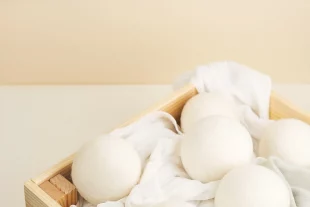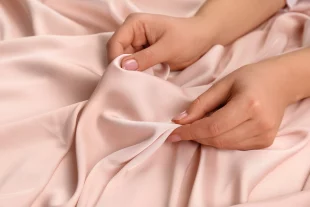 Get How-To's
Get How-To's
How to Wash Wool
👗New Service Alert – Quinceanera Dress Preservation!
Read tips, tricks, and how-to’s on our Fabric of Life blog.
Garment Guides

As cooler weather arrives and we pull out our favorite fall layers, certain fabrics need a little extra care. Materials like silk, cashmere, velvet, and down are delicate and can lose their softness or shape without proper attention. Taking time to treat these fall favorites gently now will help them stay beautiful, comfortable, and ready for the season ahead.
As the crisp air of autumn approaches and you begin reaching for your favorite layers, now is a smart moment to look closely at wardrobe care, especially for fabrics that handle change less gracefully. From silk scarves to insulated outerwear, certain garments need more than just a toss into the wash. With the right care for your fall wardrobe essentials, you’ll enjoy better performance and longer life. Before we dive in, you might want to take a look at our article on Laundry Symbols: Your Guide to Garment Care for an easier decode of those tiny tags.
Silk brings effortless elegance to your wardrobe—rich texture, smooth drape—but it’s also more fragile than many garments. Silk garments are prone to fading, snags, and shape loss when exposed to heat or strong detergents. According to specialist sources, silk should ideally be hand-washed in cool or lukewarm water with a delicate-fabric detergent. Alternatively, if machine washing is permitted, place the item in a mesh laundry bag, use the “delicate cycle”, and skip the dryer in favor of air-dry flat.
Storage matters, too: hang silk pieces in a cool, dry place out of direct sunlight, or use breathable garment bags when they’re off-season.
Takeaway: Invest in silk garment care, and your pieces will hold on to their shape and sheen far longer.
When the days shorten and the temperature dips, nothing beats slipping into a cashmere or fine wool sweater. But these fabrics call for careful treatment: they can pill, stretch, or shrink if handled improperly. A good practice: turn your sweater inside-out before washing, use a detergent made for wool or delicates, select cold water, and always lay flat to dry. Avoid wringing or hanging wet—they’ll stretch out of shape.
And when storing for the season, fold (rather than hang) to prevent distortion.
Takeaway: Proper cashmere care tips will let you enjoy softness, longevity, and style from your fine wool garments.
Your leather jacket or suede boots are go-to items for fall layering—but leather and suede need protective, fabric-specific care. While durable, these materials are vulnerable to cracking, water damage, or color fading when neglected. Experts suggest wiping down leather with a soft damp cloth, then applying a conditioner; for suede, brushing with a suede brush to restore the nap is key. Moisture exposure—especially from rain or snow—can leave permanent marks. Because of the construction complexity, professional cleaning is often the best choice for heavier leather or suede outerwear.
Takeaway: Treat your leather and suede like premium gear—focusing on leather jacket care and suede cleaning tips ensures they stay stylish and functional.
Velvet and velour make luxe appearances in fall fashion—think dresses, blazers or lounge pieces—but their plush surface requires more consideration. The pile can get crushed, flattened, or develop shiny pressure marks quite easily. One recommended approach: steam gently from the reverse side or use a low-heat steamer rather than ironing. When storing, allow ample hanging space so the fabric isn’t squeezed; if folded, place tissue between layers to protect the pile.
Takeaway: With the proper velvet garment care and velour fabric cleaning approach, you’ll preserve that rich texture that makes these pieces special.
As we approach colder months, refrigerated mornings and evenings call for outerwear that keeps you warm. That means down-filled, puffed or insulated jackets become central to your wardrobe. Yet, if these are washed incorrectly, the insulation can clump, lose loft or stop performing. Care guidance suggests using a detergent designed for down or technical outerwear and tumble drying on low with a few clean tennis balls to help “fluff” the fill. Also: store your jacket loosely (not tightly packed) so the insulation remains springy for the next season.
Takeaway: Prioritizing how to clean a down jacket and knowing insulated outerwear care will ensure you stay warm without compromising the garment’s function.
Your fall wardrobe isn’t just about what you wear—it’s about how you maintain it. Fabrics such as silk, cashmere, leather, velvet and down involve investment: monetary, style-wise and in comfort. By applying thoughtful care now, you lessen the risk of replacements, avoid surprises like shrinking or fading, and get full value from your garments. As one expert article noted, even items labeled “dry-clean only” (such as fine wool and silk) may be washed at home—but only if treated with respect.
Bottom line: Smart care isn’t just convenience—it’s a wardrobe maintenance strategy.
Fall brings change—not just in weather, but in how you treat your wardrobe. As you bring out scarves, jackets, knits and textured pieces, taking a thoughtful moment to care for the fabrics that matter most will pay dividends. Whether it’s silk that stays smooth, cashmere that keeps its softness, leather that looks sharp, velvet that retains its lush texture, or your insulated outerwear staying ready for the cold—you’ll benefit from mindful maintenance.
Ready to give your fall wardrobe the attention it deserves? Schedule a professional cleaning with CD One Price Cleaners today to ensure your favorite pieces stay in top shape all season long. Find a location near you or book online now.
We think you may like
 Get How-To's
Get How-To's
How to Wash Wool
 Get Garment Guides
Get Garment Guides
How to Use Wool Dryer Balls
 Get Garment Guides
Get Garment Guides
The Ultimate Guide to Delicates